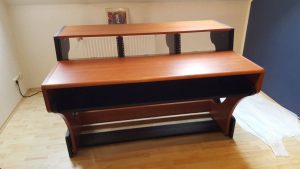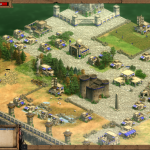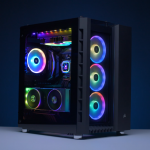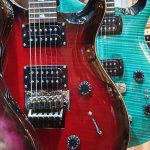Home Studio Furniture
I think you will all agree that space in your home is limited and that the right furniture is key to set up your home recording studio in that limited space. A studio desk for example is very important.
In the ideal case, you will have a spare room that you are planning to use. But still, it will usually be small rather than spacey. Reason enough to find furniture that saves space and still can host all the equipment you are planning to use. No doubt, this surely goes for the desk you will be using because it will be the center piece of your equipment.
Depending on what kind of music you make and what instruments you are playing, other factors come into play. Where and how do you sit when you play a guitar or a keybaord or when you mix or master in the end? No doubt, the chair you will be having is worth some consideration.
The Studio Desk
I was very much aware, orderly that I am, that a clean and organized workspace stands and falls with an optimal studio desk. Most of the time I would sit at that desk and do my thing. It needs to have space for the computer monitor and peripherals, the audio recording devices, keyboards and last but not least the coffee cup - and all of it in a comfortable distance so I wouldn't have to move around a lot to reach all of it.
I started looking at consumer's furniture stores first for regular office desks. I was hoping to find one that provides all of the above off the shelf if I would arrange my stuff smartly. None of the models combined all the features I needed and I was getting a little restless after a while.
I then remembered Thomann, that I had bought some instruments at before. Thomann is a Germany-based retailer of musical instruments, studio and audio equipment and it is said that they are the largest online retailer of its category worldwide. It is a great source to buy if you are located in Europe but more than that, it is a great source of information and reviews of musical equipment in general, wherever you are located.
I browsed the studio furniture section there and was instantly hooked by the versatilityof available options.
Zaor Miza 88XL
It was pretty obvious that a professional studio desk was the way to go, looking at all the specific design features targetted at home recording needs. It did not make sense to me to go with a cheaper regular office desk and find an build custom extensions and shelves to make it half-way work the way I wanted. The additional time and material was better spent in buying a professional desk.
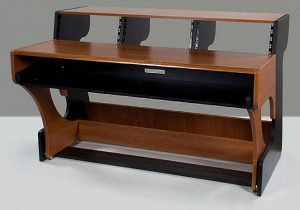 My choice fell to the Zaor Miza 88XL. Here is why:
My choice fell to the Zaor Miza 88XL. Here is why:
The number one argument for me was that that the XL model of the Miza can host a full 88 keys stage piano. I own the Yamaha P155-B and it is an ideal way to get it "out of the way" by integrating it into the desk with a drawer that you can push underneath the desktop.
The three 19" rack spaces above the desktop appealed to me equally. Many equipment is availabe in that standard size and can easily be mounted into those racks. 19" storage elements are available for unused units.
The optical design of the cherry model appealed to me as well.
The price of a little more than 900 Euros got me stuck at first. But considering the alternative of buying a cheaper alternative that would have made custom additions and the time to build them necessary, made that price not look much more expensive in the end.
Delivery and Assembly
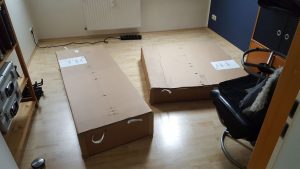 The Zaor Miza 88XL was delivered in two boxes, 39 and 69 kilogram, to my curbside. I had a friend help me carrying them into my apartment.
The Zaor Miza 88XL was delivered in two boxes, 39 and 69 kilogram, to my curbside. I had a friend help me carrying them into my apartment.
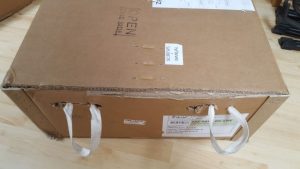 The boxes were equipped with fabric handles that supported carrying them immensly.
The boxes were equipped with fabric handles that supported carrying them immensly.
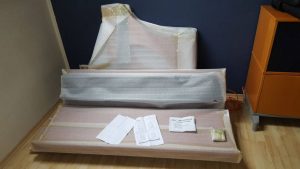 All pieces inside the boxes were wrapped in foam covers to protect them from transportation damage.
All pieces inside the boxes were wrapped in foam covers to protect them from transportation damage.
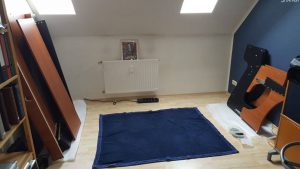 After I unwrapped all pieces I prepared some floor space for the assembly.
After I unwrapped all pieces I prepared some floor space for the assembly.
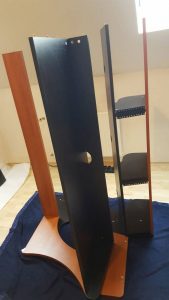 The desk is put together by fixing the horizontal parts to the right side panel and then putting the left one on top of it. The fixation is achieved by wooden bolts (already in place) and metal bolts that you have to screw into prepared threads. Excenters are screwed in to fix the pieces to the metal bolts. Pretty easy.
The desk is put together by fixing the horizontal parts to the right side panel and then putting the left one on top of it. The fixation is achieved by wooden bolts (already in place) and metal bolts that you have to screw into prepared threads. Excenters are screwed in to fix the pieces to the metal bolts. Pretty easy.
You can do all of it on your own, only putting the left side panel on top is easier with a helper because you have to align all the bolts to the side panel holes. It took about an hour to put it together.
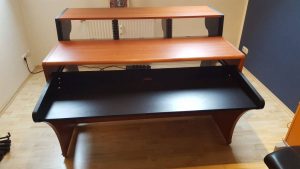 ...and the keyboard drawer works great too.
...and the keyboard drawer works great too.
Conclusion
There are only a few things that I think can be improved with this desk, e.g. adding a bottom piece to the keyboard drawer for the keyboard pedals. I think a price of 700 - 800 Euros would be more appropriate but still, the investment in this economical and thought-through studio desk was worth it. It serves every purpose that an intelligently designed desk for home recording studios should.
The desktop surface is a little higher as you would expect from an office desk. And of course it is. If you incorporate a second level for a keyboard into a desk you have to elevate the space above a little so that the keyboard drawer is not too low to play. Using a regular dining chair, the keyboard drawer fits over my legs. The desktop surface is a little high then. The optimal sitting height can easily be achieved by a chair that allows height adjustmentes. I think that is absolutely acceptable considering that your keybaord factually disappears by simply pushing the drawer back when you don't use it.
A great home studio desk, somewhat pricey, but perfectly serving optimal space usage for your musical recording equipment. It is also available in a smaller width if you don't use an 88-keys keyboard.

